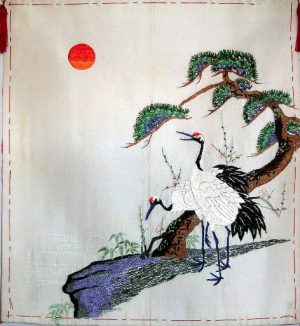Description
This stunning, hand woven, dyed, and embroidered heavy Satin Silk Fukusa or Formal Gift Cover portrays the elegant Manchurian Crane on their way to the Island of Horaisan, the Island of Everlasting Life. This is a powerful theme in Japanese life, as the magnificent Crane (“Tsuru”) must first cross the turbulent waters of Passion and Greed to achieve their goal. This is a metaphor for a young couple who, while facing struggles in their married life, should be encouraged to follow the lead of the Crane, by overcoming these difficulties to achieve lifelong connubial bliss.
This is an extraordinary example of the fine arts of Japan past. This elaborately embroidered Fukusa was commissioned by a family of very high standing within the nobility of old Japan, A Fukusa is an elaborately decorated square of cloth used to cover a gift during its formal presentation. Since ceremonial procedures permeated all facets of Japanese life, including the giving of gifts, important families commissioned famous artisans to create individual Fukusa with the intent of indicating their position in society. They were a valued part of the family’s wealth, and have been preserved for generations. It was hand woven of naturally dyed indigo Satin Silk achieving a rare turquoise coloration. The beautifully embroidered Crane are realistically portrayed flying over majestic waves comprised of pure gold threads “couched” to the silk. This precious gold thread is prepared by first painting a layer of liquid gold on thin, handmade paper, usually rice paper, and then wrapping it around several threads of silk. Because of its delicacy, it could not be sewn into the fabric; but was, instead, laid on top of the fabric and then hand stitched to it. Surprisingly, all 4 tassels remain after all this time. (the white threads along the edge are placed to hold the Fukusa in place for storing or cleaning).
As is typical of the more prestigious Fukusa from Japan’s past, the back, which is rarely seen, is also decorated. The process for this backing is that of “Tsutsugaki.” This technique requires tremendous skill, time and labor, whereby the design on the silk background, before it is dyed, must be painted out in rice paste. Once accomplished, the white of the design makes a brilliant statement. In the center stands a long tailed Tortoise (“Minokame”) representing the desire for long life as it takes the tortoise 10,000 years to reach the Island. Additionally, the long water grasses signify the old age already achieved by the tortoise. The Tortoise is surrounded by circular arabesques (“Karakusa”) which have appeared on the ceremonial clothing of nobles since the Kamakura Period (1185 AD) and is associated the Shrines of Matsuo and Izumo.
This is a remarkable example of Japan’s enduring textile Artwork commissioned from Japan’s most famous Artisans and cherished by the nobility for generations.










